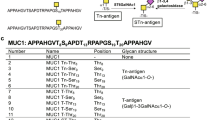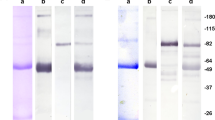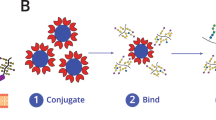Abstract
This study sought to produce monoclonal antibodies (MAbs) which reacted with the MUC2 core protein. Two MAbs [3A2 (IgG1) and 4F1 (IgM)] were produced by immunising female BALB/c mice with gel-formed mucin from the LS174T colon cancer cell line followed by a KLH conjugate of a 29 amino acid synthetic peptide whose sequence was derived from the variable number of tandem repeats (VNTR) region of a MUC2 cDNA clone. The MAbs reacted with synthetic MUC2 VNTR peptides but not synthetic MUC1 or MUC3 VNTR peptides, and showed specific reactivity in Western blotting with a high molecular weight protein produced by the LS174T colon carcinoma cell line. The use of shorter peptides indicated that the minimum peptide epitopes for these MAbs were different. Mab 3A2 reacted with amino acids 5-19 of the MUC2 VNTR by inhibition ELISA but not by direct ELISA, while 4F1 reacted with this peptide in both assays. Furthermore, 4F1 reacted in direct ELISA when a larger (29 amino acid) MUC2-derived peptide was coated onto the assay plate by incubating in carbonate buffer or by drying the peptide onto the assay plate, while 3A2 only reacted when this peptide was coated in carbonate buffer. The different specificity of the MAbs was also illustrated by the reactivity of 4F1 but not 3A2 with partially deglycosylated cystic fibrosis mucin. Immunohistochemical analysis with these MAbs revealed a strong reactivity with lung, gastric and colon tumours relative to normal tissue, with some breast and ovarian tumours also reacting. Both MAbs stained some normal goblet cells in the perinuclear region but not the mucin droplet or secreted mucin, indicating a reaction with immature (poorly glycosylated) mucin in the endoplasmic reticulum and/or golgi, but not with mature (fully glycosylated) mucin. In contrast, tumours showed strong diffuse cytoplasmic staining. 4F1 also showed weak apical cytoplasmic staining in some goblet cells and stained some tumours which showed no reactivity with 3A2. These antibodies should prove useful in the study of MUC2 structure and function, and in the diagnosis of some tumours.
This is a preview of subscription content, access via your institution
Access options
Subscribe to this journal
Receive 24 print issues and online access
$259.00 per year
only $10.79 per issue
Buy this article
- Purchase on Springer Link
- Instant access to full article PDF
Prices may be subject to local taxes which are calculated during checkout
Similar content being viewed by others
Author information
Authors and Affiliations
Rights and permissions
About this article
Cite this article
Devine, P., McGuckin, M., Birrell, G. et al. Monoclonal antibodies reacting with the MUC2 mucin core protein. Br J Cancer 67, 1182–1188 (1993). https://doi.org/10.1038/bjc.1993.223
Issue Date:
DOI: https://doi.org/10.1038/bjc.1993.223



